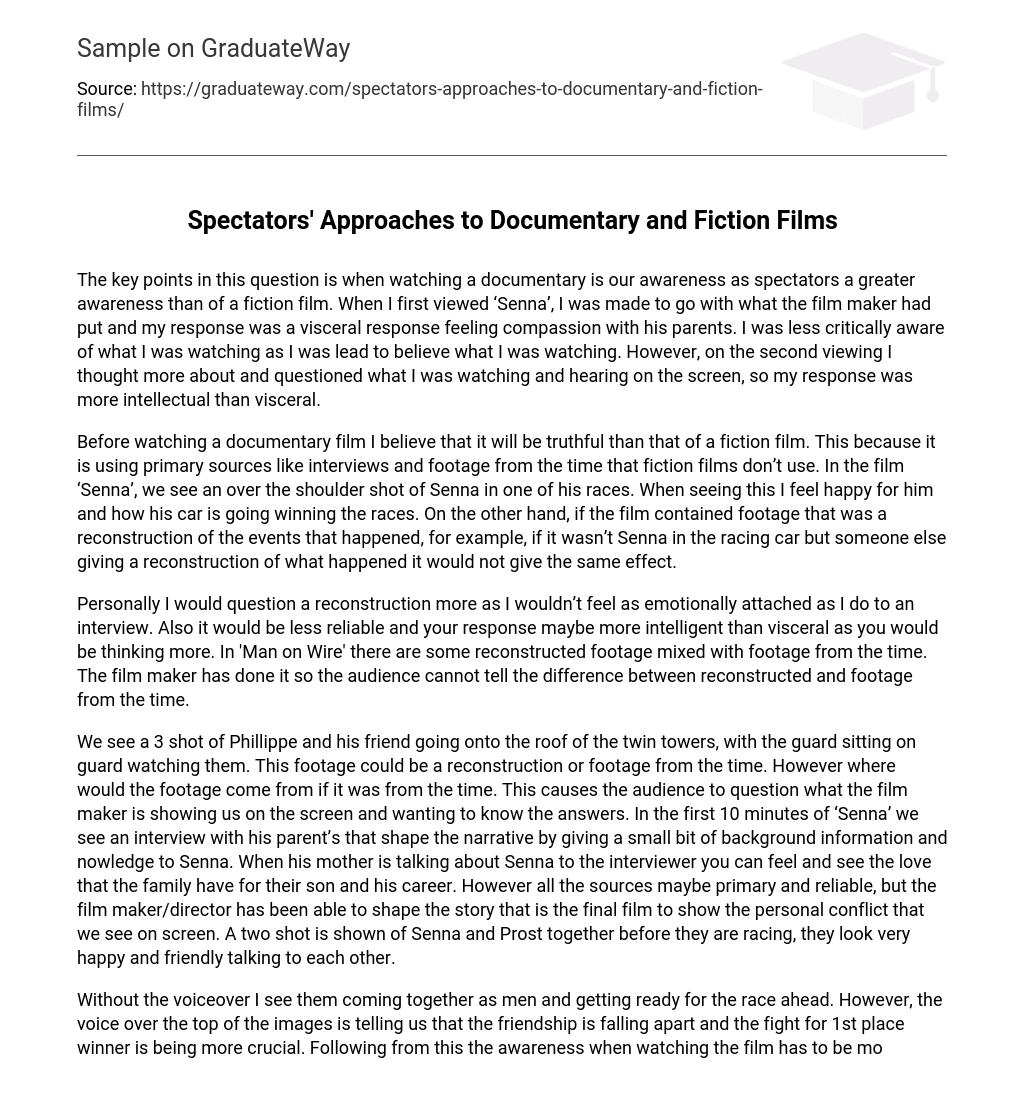The key points in this question is when watching a documentary is our awareness as spectators a greater awareness than of a fiction film. When I first viewed ‘Senna’, I was made to go with what the film maker had put and my response was a visceral response feeling compassion with his parents. I was less critically aware of what I was watching as I was lead to believe what I was watching. However, on the second viewing I thought more about and questioned what I was watching and hearing on the screen, so my response was more intellectual than visceral.
Before watching a documentary film I believe that it will be truthful than that of a fiction film. This because it is using primary sources like interviews and footage from the time that fiction films don’t use. In the film ‘Senna’, we see an over the shoulder shot of Senna in one of his races. When seeing this I feel happy for him and how his car is going winning the races. On the other hand, if the film contained footage that was a reconstruction of the events that happened, for example, if it wasn’t Senna in the racing car but someone else giving a reconstruction of what happened it would not give the same effect.
Personally I would question a reconstruction more as I wouldn’t feel as emotionally attached as I do to an interview. Also it would be less reliable and your response maybe more intelligent than visceral as you would be thinking more. In ‘Man on Wire’ there are some reconstructed footage mixed with footage from the time. The film maker has done it so the audience cannot tell the difference between reconstructed and footage from the time.
We see a 3 shot of Phillippe and his friend going onto the roof of the twin towers, with the guard sitting on guard watching them. This footage could be a reconstruction or footage from the time. However where would the footage come from if it was from the time. This causes the audience to question what the film maker is showing us on the screen and wanting to know the answers. In the first 10 minutes of ‘Senna’ we see an interview with his parent’s that shape the narrative by giving a small bit of background information and nowledge to Senna. When his mother is talking about Senna to the interviewer you can feel and see the love that the family have for their son and his career. However all the sources maybe primary and reliable, but the film maker/director has been able to shape the story that is the final film to show the personal conflict that we see on screen. A two shot is shown of Senna and Prost together before they are racing, they look very happy and friendly talking to each other.
Without the voiceover I see them coming together as men and getting ready for the race ahead. However, the voice over the top of the images is telling us that the friendship is falling apart and the fight for 1st place winner is being more crucial. Following from this the awareness when watching the film has to be more critical, to be able to question what is being shown by the film maker. In the film ‘The Filth and the Fury’ the first few minutes is a montage sequence of footage from fights.
We as British people were being manipulated and the voiceover telling us that everything was falling apart. So greater critical awareness was need to listen and then question what was being said. In my first viewing of ‘Senna’, I went along with what the film was telling me. Being lead on by what the film maker was implying and telling the audience through the editing of footage and sound. On my second viewing it got me thinking more and questioning. When Senna had stopped in the pit stop, the voiceover told us that Nanni had gone past and was in the lead.
We also hear the sound of a car zooming past so are made to believe that he has gone past. But when Senna is pulling out from the pit stop, we see a car just in front of him. No other car is mentioned to have gone past Senna while in the pit stop so must Nanni. This has been edited and moved in the editing process by the film maker, shaping the narrative by creating a chase like scene and also shaping the character of Senna and the need he has to try and win now somebody is in front. Man on Wire has the same genre as a heist fiction film.
Oceans 11 is a heist film where everyone is going for something, like in ‘Man on Wire’ where the end result is Phillippe walking over the twins towers. bA non diegetic soundtrack over the top of the clips of Phillippe getting onto the roof. Like a fiction heist film it builds the suspense for the audience wondering and hoping that they won’t get caught. But to know we are aren’t watching a fiction film, there are interview voice overs without their talk heads which continues the narrative.
Despite being manipulated by the film I feel that on balance you are more critically aware of a documentary film because it is aiming to present the facts. That on the whole I feel fiction films are able to disarm you more because as spectators you have to use your imagination and get drawn in by that world that is created in your mind. However, in documentaries we have to think more about the narrative as it doesn’t capture the imagination like a fiction film. Also the choice of shots and soundtrack has been chosen by the film maker and could have been manipulated.





